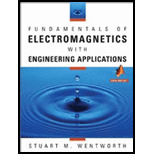Problem 2.1P: Given P(4, 2, 1) and APQ=2ax+4ay+6az, find the point Q. Problem 2.2P Problem 2.3P Problem 2.4P: Suppose Q1(0.0,-3.0m,0.0)=4.0nC, Q2(0.0,3.0m,0.0)=4.0nC, and Q3(4.0m,0.0,0.0)=1.0nC. (a) Find the... Problem 2.5P Problem 2.6P: Suppose 10.0nC point charges are located on the corners of a square of side 10.0 cm. Locating the... Problem 2.7P: Four 1.00nC point charges are located at (0.00,2.00m,0.00), (0.00,2.00m,0.00), (0.00,0.00,2.00m),... Problem 2.8P: A 20.0nC point charge exists at P(0.00,0.00,3.00m). Where must a 10.0nC charge be located to make... Problem 2.9P Problem 2.10P: Convert the following points from Cartesian to Cartesian coordinates: P(3.0,30.,45.) Q(5.0,/4,3/2)... Problem 2.11P Problem 2.12P Problem 2.13P Problem 2.14P: A 20.0–cm–long section of copper pipe has a 1.00–cm–thick wall and outer diameter of 6.00... Problem 2.15P: A line charge with charge density 2.00nC/m exists at y=2.00m,x=0.00. (a) A charge Q=8.00nC exists... Problem 2.16P: You are given two z–directed line charges of charge density +1.0nC/m at x=0,y=1.0m and of charge... Problem 2.17P: Suppose you have a segment of line charge of length 2L centered on the z–axis and having a charge... Problem 2.18P: A segment of line charge L=10.nC/m exists on the y-axis from the origin to y=+3.0m. Determine E at... Problem 2.19P: In free space, there is a point charge Q=8.0nC at (2.0m,0,0), a line charge L=10.nC/m at y=9.0m,... Problem 2.20P Problem 2.21P: Sketch the following surfaces and find the total charge on each surface given a surface charge... Problem 2.22P: Consider a circular disk in the x–y plane of radius 5.0 cm. Suppose the charge density is a... Problem 2.23P: Suppose a ribbon of charge with density S exists in the y–z plane of infinite length in the z... Problem 2.24P: Sketch the following volumes and find the total charge for each given a volume charge density of... Problem 2.25P: You have a cylinder of 4.00–in diameter and 5.00–in length (imagine a can of tomatoes) that has... Problem 2.26P: Consider a rectangular volume with 0.00x4.00m,0.00y5.00m, and 6.00mz0.00 with charge density... Problem 2.27P Problem 2.28P Problem 2.29P: Given D=2a+sinazC/m2, find the electric flux passing through the surface defined by 2.04.0m, 90.180,... Problem 2.30P: Suppose the electric flux density is given by D=3rarcosa+sin2aC/m2. Find the electric flux through... Problem 2.31P Problem 2.33P: A cylindrical pipe with a 1.00–cm wall thickness and an inner radius of 4.00 cm is centered on the... Problem 2.34P Problem 2.35P Problem 2.36P: A thick–walled spherical shell, with inner radius 2.00 cm and outer radius 4.00 cm, has an evenly... Problem 2.37P Problem 2.38P: Determine the charge density at the point P(3.0m,4.0m,0.0) if the electric flux density is given as... Problem 2.39P: Given D=3ax+2xyay+8x2y3azC/m2, (a) determine the charge density at the point P(1,1,1). Find the... Problem 2.40P: Suppose D=6cosaC/m2. (a) Determine the charge density at the point (3m,90,2m). Find the total flux... Problem 2.41P: Suppose D=r2sinar+sincosaC/m2. (a) Determine the charge density at the point (1.0m,45,90). Find the... Problem 2.42P Problem 2.43P: A surface is defined by the function 2x+4y21nz=12. Use the gradient equation to find a unit vector... Problem 2.44P: For the following potential distributions, use the gradient equation to find E. V=x+y2z(V) V=2sin(V)... Problem 2.45P: A 100nC point charge is located at the origin. (a) Determine the potential difference VBA between... Problem 2.46P Problem 2.47P Problem 2.48P Problem 2.49P: Suppose a 6.0–m–diameter ring with charge density 5.0nC/m lies in the x–y plane with the... Problem 2.50P Problem 2.51P Problem 2.52P: The typical length of each piece of jumper wire on a students protoboard is 5.0 cm. Assuming... Problem 2.53P: A 150–m length of AWG–22 (0.644 mm diameter) copper magnet wire with a very thin insulative... Problem 2.54P: Determine an expression for the power dissipated per unit length in coaxial cable of inner radius a,... Problem 2.55P: Find the resistance per unit length of a stainless steel pipe of inner radius 2.5 cm and outer... Problem 2.56P: A nickel wire of diameter 5.0 mm is surrounded by a 0.50–mm–thick layer of silver. What is the... Problem 2.57P Problem 2.58P: A 20nC point charge at the origin is embedded in Teflon (r=2.1). Find and plot the magnitudes of the... Problem 2.59P: Suppose the force is very carefully measured between a pair of point charges separated by a... Problem 2.60P: The potential field in a material with r=10.2 is V=12xy2(V). Find E, P, and D. Problem 2.61P: In a mineral oil dielectric, with breakdown voltage of 15MV/m the potential function is... Problem 2.62P Problem 2.63P: For z0,r1=9.0 and for z0,r2=4.0. If E1 makes a 300 angle with a normal to the surface, what angle... Problem 2.64P Problem 2.65P: Consider a dielectric–dielectric charge–free boundary at the plane z=0. Construct a program that... Problem 2.66P: A 1.0–cm–diameter conductor is sheathed with a 0.50–cm thickness of Teflon and then a 2.0–cm... Problem 2.67P Problem 2.68P: For a coaxial cable of inner conductor radius a and outer conductor radius b and a dielectric r in... Problem 2.69P Problem 2.70P Problem 2.71P: A parallel–plate capacitor with a 1.0m2 surface area for each plate, a 2.0–mm plate separation,... Problem 2.72P Problem 2.73P Problem 2.74P: Given E=5xyax+3zaZV/m, find the electrostatic potential energy stored in a volume defined by 0x2m,... Problem 2.75P: Suppose a coaxial capacitor with inner radius 1.0 cm, outer radius 2.0 cm, and length 1.0 m is... format_list_bulleted


 Electricity for Refrigeration, Heating, and Air C...Mechanical EngineeringISBN:9781337399128Author:Russell E. SmithPublisher:Cengage Learning
Electricity for Refrigeration, Heating, and Air C...Mechanical EngineeringISBN:9781337399128Author:Russell E. SmithPublisher:Cengage Learning